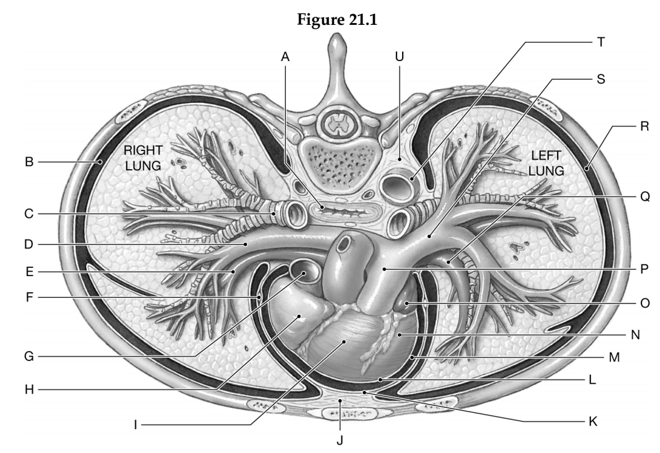Using the figure below, identify the labeled part.

1. Label A: ______________________________
2. Label B: ______________________________
3. Label C: ______________________________
4. Label D: ______________________________
5. Label E: ______________________________
6. Label F: ______________________________
7. Label G: ______________________________
8. Label H: ______________________________
9. Label I: ______________________________
10. Label J: ______________________________
11. Label K: ______________________________
12. Label L: ______________________________
1.3 Label M: ______________________________
14. Label N: ______________________________
15. Label O: ______________________________
16. Label P: ______________________________
17. Label Q: ______________________________
18. Label R: ______________________________
19. Label S: ______________________________
20. Label T: ______________________________
21. Label U: ______________________________
1. Esophagus
2. Right pleural cavity
3. Bronchus of lung
4. Right pulmonary artery
5. Right pulmonary vein
6. Phrenic nerve
7. Superior vena cava
8. Right atrium
9. Right ventricle
10. Anterior mediastinum
11. Parietal pericardium
12. Epicardium (visceral pericardium)
1.3 Pericardial cavity
14. Left ventricle
15. Left atrium
16. Pulmonary trunk
17. Left pulmonary vein
18. Left pleural cavity
19. Left pulmonary artery
20. Aorta (arch segment removed)
21. Posterior mediastinum
You might also like to view...
The broad ligament is a(n)
A) extensive mesentery that encloses the ovaries, uterine tubes, and uterus. B) thickened fold of mesentery that supports and stabilizes the position of the ovary. C) pocket formed between the posterior wall of the uterus and the anterior surface of the rectum. D) structure that anchors the ovary to the recto-uterine pouch. E) structure that extends from the lateral surface of the ovary to the pelvic wall.
Why does damaged endothelium present an increased risk of blood clotting?
What will be an ideal response
Second messengers are triggered as a response to:
A) steroid hormones B) anabolic steroids C) peptide hormones D) all of the above E) none of the above
Over-secretion of growth hormone in children causes ________.
A. acromegaly B. gigantism C. pituitary cachexia D. myxedema